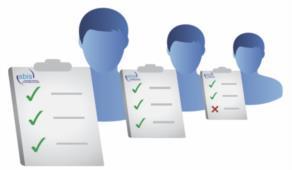Every week hundreds of patients are discharged from London hospitals and for some, a comprehensive package of continuing care provided by health and social care teams within nursing or patients homes is essential.
Homerton Hospital in Hackney – part of Homerton University Hospital Trust – has developed a smart electronic solution that makes the process of completing all the associated paperwork much easier, quicker and cost effective; bringing benefits to the hospital, social care teams, patients and carers alike.
The solution, which incorporates NHSmail, allows staff to complete continuing care paperwork electronically and share it with relevant parties via secure email. Even better, the solution was developed and implemented in a matter of weeks as part of the Discharge team’s regular work, with no extra costs involved.
Cutting down the paper chase
For vulnerable patients with complex needs such as many older people, it’s only when an appropriate package of care is in place and approved by the relevant Advisory Panel, that they can be safely discharged from hospital.
Advisory Panels agree decisions based on the information about each individual case submitted on forms by NHS and local authority staff. The forms, which can consist of 80+ pages for a single patient, contain a lot of repetitive information so completing them by hand puts extra pressure on clinicians working on busy hospital wards.
Problems are compounded when it comes to sharing the information between hospital and local authority professionals. At Homerton, fax machines were routinely used to send discharge and continuing care paperwork to the Advisory Panel. A recent audit of London boroughs shows that this practice is widespread. In cases where paperwork is incomplete or illegible, Advisory Panels are forced to defer decisions, meaning patients have to remain in hospital longer than absolutely necessary – often up to two weeks more. With bed blocking a major concern for the NHS, this is clearly unacceptable.
Michele Stenning, Acute Discharge Planning Service lead at Homerton and with support from the Continuing Care Administrator Alan Worrow, spotted the potential for transforming the process for completing and sharing continuing care applications.
Working closely with clinical staff their first step was to develop a simple macro using the hospital’s existing shared drive, so that ward staff could complete vital paperwork electronically. The system allows for automatic copying of repetitive but necessary information throughout and across the forms. It’s simple and user friendly, and can be easily adapted for other important areas such as social services.
Using the shared server means that clinicians can complete continuing care forms from any hospital computer, which also gives them more flexibility and allows greater oversight by the Discharge team.
Most importantly, the quality of information now received by the Hackney Continuing Care Panels is much higher because it’s typed and more accurate. The result is fewer deferrals and hold-ups for patients.
Secure email for faster information sharing
Importantly, the Homerton solution moves away from fax to secure email.
“Faxing is not reliable or secure enough for sharing sensitive documents like continuing care applications,” says Keith Strahan, Health and Social Care Programme Manager for NHS London, “Yet it’s still the standard way of sharing information in health and social care in London.”
It’s also costly – both in terms of maintaining and running of fax machines, and environmentally. Multiply the typical 80 page patient document just a few times and you get the picture of how much paper is involved.
Strahan’s team were looking at how information could be exchanged more effectively and at no cost using secure email such as NHSmail and GCSX used by Local Authorities. The Homerton continuing care development was exactly the kind of initiative they wanted to encourage.
It wasn’t just the faxing that made the process of information sharing cumbersome though. “Discharge coordinators can spend a lot of time collecting paperwork from wards,” says Michele Stenning. “In Homerton, we were doing two ward rounds per day. But now there’s a built-in alert to let us know new forms have been submitted and our administrators can simply pick up the documents on the computer in their office and send them on via NHSmail. It’s saving us at least two hours a day in admin staff time.”
Since introducing the new system, Homerton believe they’ve saved over £30k in “bed days” and a further £10k in paper savings for Homerton and the Hackney Continuing Care Panel. Michele Stenning adds “the new process means less stress for the patient and their family as well as enabling the community and nursing home teams, who support these patients when they leave hospital, to balance their workload and plan their support more effectively”
The solution is now being shared free of charge with teams involved in discharge or continuing care in other London hospitals and care organisations, including hospices – with a view to making the vision of a paperless discharge system a reality.
Source: NHS Connecting for Health

